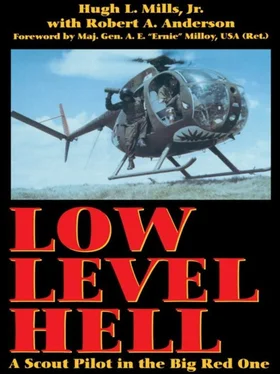As soon as we were on the air cav side of the runway, I noticed a big change in the way things looked. At least the drab paint color changed. Back on the battalion side, the numeral 1 was painted big and red everywhere; it represented the division’s shoulder patch insignia. Here everything was painted red and white, U.S. Cavalry flag colors. I mean everything—the signs, the hootches, even the rocks on the ground that outlined the walkways. I said to myself, here’s the good old cavalry pride and spirit; I’m really going to like this place!
In front of the flight operations building, a large concrete sign announced Troop D (Air), 1st Squadron, 4th U.S. Cavalry—Darkhorse. I liked the name Darkhorse. It had pizzazz and said something about the flair and fighting spirit of the troop.
On the runway I saw a lineup of sleek, new AH-1G Cobras and OH-6A scout ships. These were the first Cobras I had seen up close, but I knew that the armament they carried was awesome. They had the firepower to ruin the day of anyone on the receiving end. Their 7.62mm miniguns could pump out four thousand rounds a minute. Then there was the 40mm grenade launcher, and the arsenal of 2.75-inch rockets under each stubby little wing. That aircraft was like a flying tank!
The troop first sergeant, Martin Laurent, met me at the door of the orderly room and relieved me of my duffel bag. The troop commander—Major Cummings—was right there also to shake my hand and introduce himself, then he pointed me into his office. Offering me a seat, he settled himself behind his desk. After studying me for a moment, he broke the silence. “Where you from, Mills?”
“Arkansas, sir… Hot Springs.”
He nodded and picked up my file that First Sergeant Laurent had laid on his desk. “I see you’re an armor officer and right out of flight school. Do you have any special qualifications we should know about?” he asked, leaning back in his chair.
“No,” I responded, “I’m basically qualified in utility aircraft with training as a gunship pilot. I’m not qualified in the Cobra, but I certainly would like to fly scouts. I’ve wanted to be a scout pilot ever since I first saw the OH-6A.”
The major pushed even farther back in his chair, stroked his chin a couple of times, and then wrung his hands together. I could tell that this was not what he had in mind. “I appreciate knowing your feelings, Lieutenant,” he frowned, “but I don’t have any vacancies in the scouts right now. What I do need is a lieutenant in the slick platoon.”
Damn, I thought.
“However,” he continued, “the platoon leader over in scouts is Lieutenant Herchert, and he might be moving over to flight operations one of these days soon. If that happens, I’ll see to it that you get first crack at scouts.”
After a bit more small talk, the major wound things up. “Mills, I’m assigning you to our lift platoon. Their mission is to airlift our aerorifle platoon using the Hueys. Any questions?”
“No, sir,” I said, “I guess I’m the new guy, and I’d better learn what’s going on in the lift section.” Then, lying through my teeth, I added, “Yes, sir, the lift platoon will be just fine.” All I could do was hope that the major picked up on my disappointment, and would remember my request for scouts as soon as there was an opening.
As I left the Old Man’s office, I met another lieutenant who was staríding in the orderly room. He turned to me. “Hi, you the new guy?”
“Yes, my name’s Mills and I’m going to the lift section.”
“Great,” he said. “I’m Wayne McAdoo, assistant platoon leader for the slicks. We’re called the Clowns, or the Flying Circus. Come on, I’ll walk you over to the hootches and help you find a bunk.”
McAdoo took me across a small drainage ditch to the troop officers’ hootches. As I entered, I noticed that connecting the hootch to the next building in line was a large built-up bunker with no exterior entrance. Sandbags covered the whole thing from top to ground level. I was told that, in case of incoming rocket and artillery fire, we could dive into the bunker without having to go outside the hootch. The entrance hole was located right at the foot of my bunk.
McAdoo helped me move my clothes into the wall locker, then suggested that we meet some of the other guys. Bunking across from me was a warrant officer dressed only in ragged cutoff khaki shorts and a pair of shower shoes. He was comfortably propped up on his bunk, listening to the rock music that flooded the room from the stereo player. Warrant Officer Bob Davis was from Barberton, Ohio, and a scout pilot. He had been in Vietnam for only two to three weeks. The more I looked at him, the more I was convinced that I had seen him someplace before. As it turned out, Davis had been in flight school at Fort Rucker at the same time I was.
Everybody in the hootch was friendly, but nobody came rushing up to greet me. They just nodded approvingly, and invariably asked the same question: “Where are you assigned… slicks, guns, or scouts?” Continuing around the hootch with McAdoo, I next met Barney Stevens, a slick pilot and a warrant officer first class. Then there was 1st Lt. Dean Sinor, CW2. Benny Parker, and, finally, Capt. Don Trent. Sinor, Parker, and Trent were Cobra pilots in the gun platoon.
It became obvious that the pilots didn’t live together in their respective platoon hootches. Every hootch had a mixture of gun, scout, and slick pilots. There was no caste system; every man had the same basic living area, consisting of an army standard metal folding bunk with a book-thin mattress, covered with what looked to be a nylon camouflage poncho liner. Every man had a foot locker at the end of his bed, as well as an individual wall locker. And everybody—to a man—had a portable, pedestal fan. In each of the hootches was a small bar space with a hot plate, refrigerator, small storage area, and generally a television and a stereo set with tape deck. Not a bad setup for the middle of a war zone.
The next person I met was Bob Harris, the aerorifle (ARP) platoon leader. He filled me in on the platoon’s job and how his twenty-eight-man unit of select infantrymen fit into overall troop operations.
Next stop was supply, where the first thing I was given was an APH-5 flight helmet. “It’s supposed to be bullet resistant,” the supply sergeant told me. Next, I went to the arms room for the issue of a personal weapon. The armorer handed me the pilot’s standard side arm, a .38-caliber model number 10 Smith and Wesson revolver. While he was shoving the .38 across the counter to me, I was studying the rack behind him, filled with .45 automatic pistols, 1911 Als, and M-16 and CAR-15 rifles. I was particularly intrigued by the CAR-15; it was a shortened version of the M-16 that had been developed for commando use.
I pushed the .38 back across the counter. “I really don’t want a revolver. How about one of those .45 s?”
He looked a little surprised. “But, sir, not one of the pilots carries a .45.”
I grinned at him. “But I’m just not one of the pilots, and I would rather have a .45.”
“Lieutenant, you can have whatever side arm you want,” and he reached behind him for a .45 automatic and a couple of magazines of ammo.
“And I would also like one of those CAR-15s.”
“Sorry, sir, the CAR-15s are reserved for the Cobra and scout pilots.”
“OK, then, how about an M-16?”
I knew that the armorer was beginning to wonder just what kind of a first lieutenant he had run into. But he reached behind him, pulled out an M-16, and signed it out to me along with the .45. Most pilots coming into Vietnam for the first time probably didn’t have a real preference as to what firearms they were issued. But I had been around guns all my life—my Uncle Billy had introduced me to guns as soon as I was old enough to hold one. I just felt more secure with a hardhitting .45 strapped on.
Читать дальше












